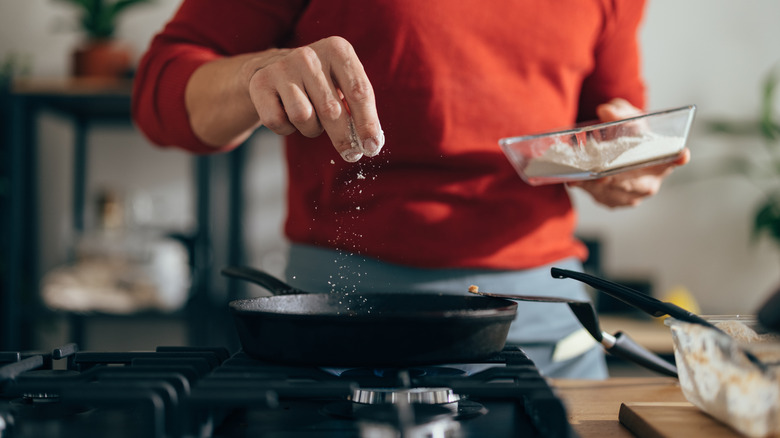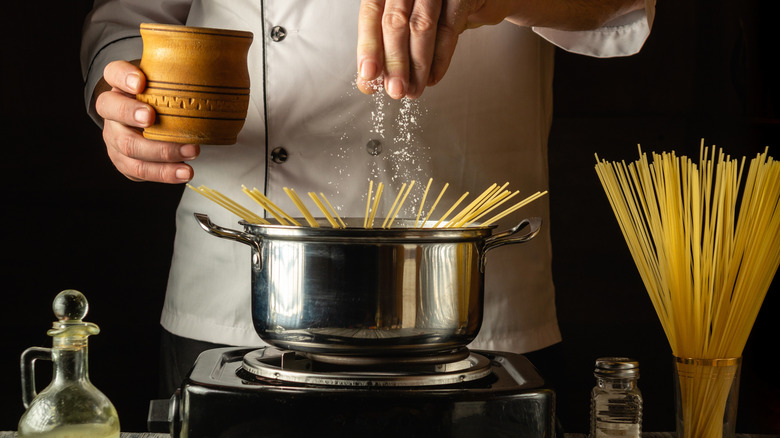The Basic Cooking Mistake Everyone Makes With Salt
It may not seem that important to a novice chef, but properly salting your food is as vital as any cooking technique. In fact, once culinary aspirants nail down proper salting, it's the easiest way to level themselves up from a beginner to someone who will have people RSVPing well in advance of their next dinner party. Naturally, salting food is nuanced. It can be used to draw moisture out of meat and veggies and enhance the flavor in almost any ingredient, but there's one basic cooking mistake everyone makes with salt: adding salt after the dish is done.
The most straightforward advice to give when it comes to salting while cooking is to salt during every stage of cooking and season as you go. That means when you're whipping up some mashed potatoes, incorporate a few pinches every few minutes to taste. Make sure to taste test as you go, and you'll be well on your way to one of the best dishes you've ever made. If you throw some salt on top of your dish after it's complete, you'll be left with an uneven, grainy, and salty finish. And remember, when using salt, you're using salt to bring out flavors, not just to make something salty.
When to salt before and during cooking
Knowing exactly when to salt is just as important as the recipe's instructions and cooking temperature. It's all part of a greater whole that will eventually become your delicious meal. A general rule of salting is to salt before you begin cooking, then throughout the process. A little as you go through each stage. But it all starts with the first salt. One of the most specific and well-known pre-cooking salting techniques is when you salt a steak. Adding a hefty amount of salt to coat both sides of your steak before you sear it in a pan will pull moisture out of the meat, leading to that perfect crispy sear.
Another pre-cook salting staple you need to know is salting pasta water. Get that water to a good boil so the bubbles disrupt the salt and aid in its dissolving, then throw in a few pinches of salt to taste. An old adage says water should be "as salty as the sea", but most chefs think it should be a step or two below that. In other words, you can taste it, and it won't make your face pucker; it will just be salty, ready to soak up the starch and flavor your noodles. Or if you want to be more scientific about it, a 1% or 2% salt-to-water ratio should be perfect.
When to salt after cooking
Of course, there are certain foods and situations when you add a hefty sprinkle of salt after putting together your dish. This is finishing salt, and it's for specific dishes and ingredients. Adding finishing salt can bring out new flavors in your food or give a perfect texture to roasted vegetables or fish. The most well-known, made famous by the restaurateur and food influencer Salt Bae, is to finish your steak with a hefty pinch of salt after cooking. But you can also add a sprinkle of salt and pepper to a salad, fried potatoes, fish, chicken, and more. Remember — it's a flavor enhancer. You should constantly add pinches of salt as you cook and taste your recipe.
The type of salt you use in your cooking will also matter. Table salt, sea salt, and kosher salt all have little differences that you need to be aware of. Most professionals use kosher salt because it doesn't have the iodine found in table salt, which can have a metallic flavor, and has fine grains that can easily overpower your dish. The large kosher salt crystals also allow the salt to season more evenly, making the crystals easier to pick up with your hands. If it's your first time using kosher salt, it can be a little intimidating to get used to, but the results are well worth it.


